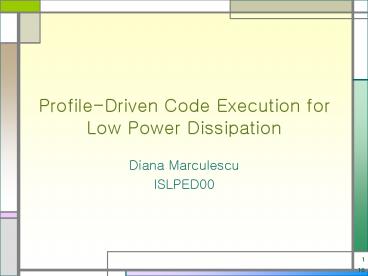ProfileDriven Code Execution for Low Power Dissipation - PowerPoint PPT Presentation
1 / 16
Title:
ProfileDriven Code Execution for Low Power Dissipation
Description:
... for code annotation that select run-time the optimal number ... dk is the average Hamming distance between input vectors that are exactly k steps apart. ... – PowerPoint PPT presentation
Number of Views:61
Avg rating:3.0/5.0
Title: ProfileDriven Code Execution for Low Power Dissipation
1
Profile-Driven Code Execution for Low Power
Dissipation
- Diana Marculescu
- ISLPED00
2
Introduction
- ? an optimal level of parallelism for energy
consumption - ? a compiler-assisted technique for code
annotation that select run-time the optimal
number of instructions to be fetched or executed
in parallel as far as energy is concerned. - Software-driven and a fine grain energy
characterization on a per basic block, per
process basis.
3
Introduction
- In superscalar processors, the hardware may
execute from one to eight instruction per cycle. - If a certain instruction is dependent or doesnt
meet the constraint, - only the instruction preceding it in the
sequence are issues, - hence the variability in issue rate.
4
Example
- Four 16-bit multipliers able to perform the
multiplication
Total energy per operation
5
Profile-Driven Instruction Execution for energy
Optimization
- Analytic model
- The effect of speculative execution
6
Analytic model
- Power consumption is a function of the switched
capacitance of a module. - So, use the average Hamming distance.
7
Analytic model
- Proposition 1
- If an input sequence Xnn gt 0 is modeled by a
lab-one Matkov chain, p(x) is the probability of
occurrence of vector x and pk(xy) is the
conditional probability of making a transition
from y to x in exactly k steps, then the average
Hamming k-distance denoted -
converges when k -gt 8 and the limit is
8
Analytic model
- dk is the average Hamming distance between input
vectors that are exactly k steps apart. - Thus, dk is a measure of the average switching
activity when exactly k units are used to process
the input sequence I parallel.
9
Analytic model
- If a data trace Xnn gt 0 is modeled by a
lab-one Matkov chain, and Ek Em(dk) is the
energy consumed per operation when k identical
functional units are available, then - where Em is the energy macromodel and D is as in
Proposition 1.
10
Analytic model
- The results presented above offers an answer to
what is the optimal number of instructions to be
executed in parallel?. - The energy cost per operation for k instructions
issued in parallel is proportional to dk..
11
The effect of speculative execution
If the branch Is mispredicted
12
Profile-Driven Code-Annotation for Low-Energy
Code Execution
- In practice, computing dk using proposition(1) is
so expensive since it implies repeated matrix
multiplications. - The result do not capture the effect of
speculative execution. - Thus, propose profile-driven methodology to find
the optimal number of instructions to be executed
in parallel for each basic block.
13
Profile-Driven Code-Annotation for Low-Energy
Code Execution
- Assume that the input program is simulated for a
typical input stream with an execution rate
varying between 1 and K.
14
Profile-Driven Code-Annotation for Low-Energy
Code Execution
- After collecting the statistics for each basic
block, - the value of k which gives the minimum value of
switched capacitance for the execution stage is
used to annotate all instructions in the basic
block under consideration.
15
Experimental Results
16
Conclusion
- Present a novel technique for code optimization
for low power based on profile driven
methodology. - The technique can be used as means
- for prolonging the battery life by decreasing
the energy consumption, - for the thermal management by achieving
significant average power reduction in the
execution stage.































